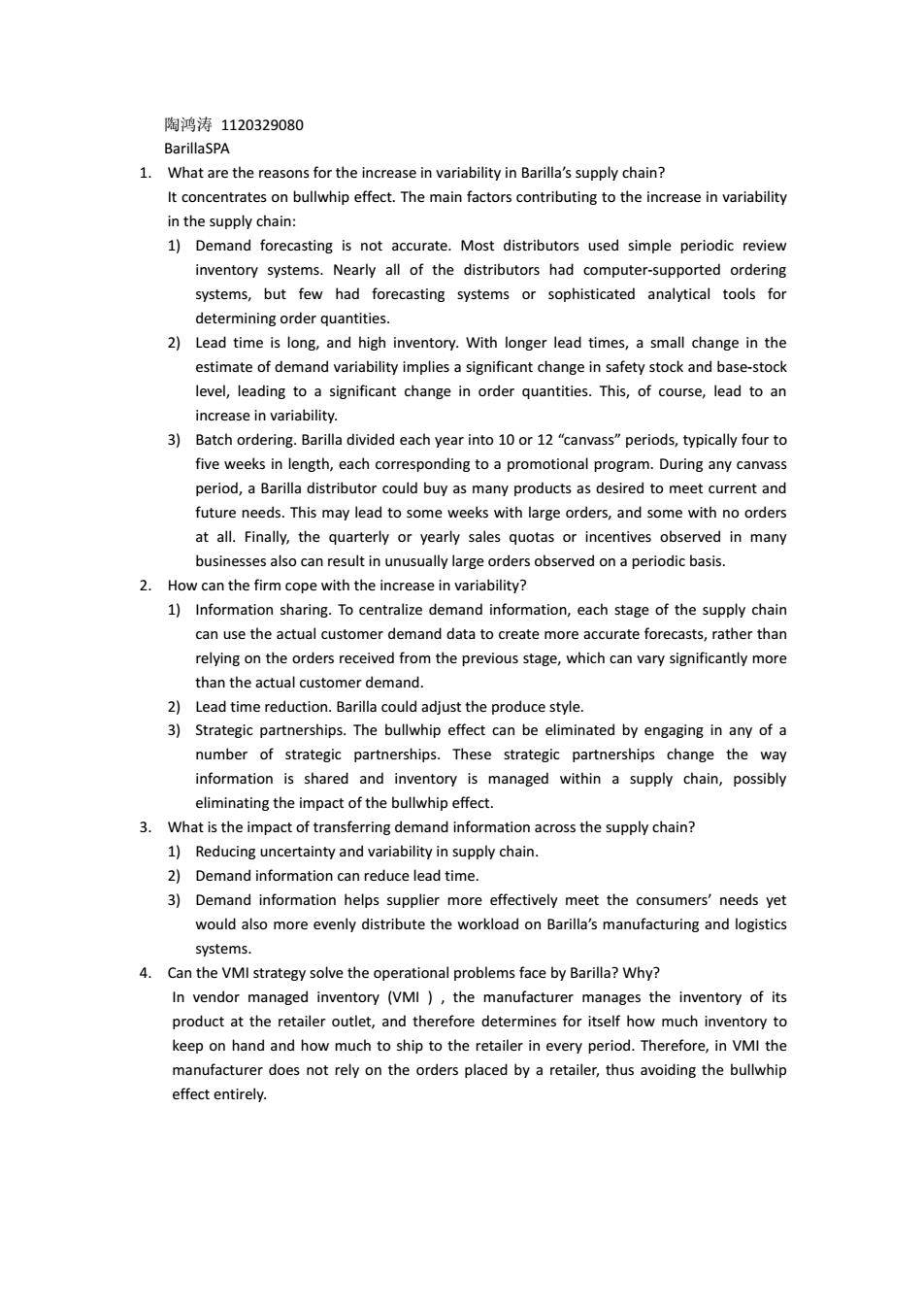
陶鸿涛1120329080 BarillaSPA 1.What are the reasons for the increase in variability in Barilla's supply chain? It concentrates on bullwhip effect.The main factors contributing to the increase in variability in the supply chain: 1)Demand forecasting is not accurate.Most distributors used simple periodic review inventory systems.Nearly all of the distributors had computer-supported ordering systems,but few had forecasting systems or sophisticated analytical tools for determining order quantities. 2)Lead time is long,and high inventory.With longer lead times,a small change in the estimate of demand variability implies a significant change in safety stock and base-stock level,leading to a significant change in order quantities.This,of course,lead to an increase in variability. 3)Batch ordering.Barilla divided each year into 10 or 12 "canvass"periods,typically four to five weeks in length,each corresponding to a promotional program.During any canvass period,a Barilla distributor could buy as many products as desired to meet current and future needs.This may lead to some weeks with large orders,and some with no orders at all.Finally,the quarterly or yearly sales quotas or incentives observed in many businesses also can result in unusually large orders observed on a periodic basis. 2.How can the firm cope with the increase in variability? 1)Information sharing.To centralize demand information,each stage of the supply chain can use the actual customer demand data to create more accurate forecasts,rather than relying on the orders received from the previous stage,which can vary significantly more than the actual customer demand. 2)Lead time reduction.Barilla could adjust the produce style. 3)Strategic partnerships.The bullwhip effect can be eliminated by engaging in any of a number of strategic partnerships.These strategic partnerships change the way information is shared and inventory is managed within a supply chain,possibly eliminating the impact of the bullwhip effect. 3.What is the impact of transferring demand information across the supply chain? 1)Reducing uncertainty and variability in supply chain. 2)Demand information can reduce lead time. 3)Demand information helps supplier more effectively meet the consumers'needs yet would also more evenly distribute the workload on Barilla's manufacturing and logistics systems. 4.Can the VMI strategy solve the operational problems face by Barilla?Why? In vendor managed inventory (VMI )the manufacturer manages the inventory of its product at the retailer outlet,and therefore determines for itself how much inventory to keep on hand and how much to ship to the retailer in every period.Therefore,in VMI the manufacturer does not rely on the orders placed by a retailer,thus avoiding the bullwhip effect entirely
陶鸿涛 1120329080 BarillaSPA 1. What are the reasons for the increase in variability in Barilla’s supply chain? It concentrates on bullwhip effect. The main factors contributing to the increase in variability in the supply chain: 1) Demand forecasting is not accurate. Most distributors used simple periodic review inventory systems. Nearly all of the distributors had computer-supported ordering systems, but few had forecasting systems or sophisticated analytical tools for determining order quantities. 2) Lead time is long, and high inventory. With longer lead times, a small change in the estimate of demand variability implies a significant change in safety stock and base-stock level, leading to a significant change in order quantities. This, of course, lead to an increase in variability. 3) Batch ordering. Barilla divided each year into 10 or 12 “canvass” periods, typically four to five weeks in length, each corresponding to a promotional program. During any canvass period, a Barilla distributor could buy as many products as desired to meet current and future needs. This may lead to some weeks with large orders, and some with no orders at all. Finally, the quarterly or yearly sales quotas or incentives observed in many businesses also can result in unusually large orders observed on a periodic basis. 2. How can the firm cope with the increase in variability? 1) Information sharing. To centralize demand information, each stage of the supply chain can use the actual customer demand data to create more accurate forecasts, rather than relying on the orders received from the previous stage, which can vary significantly more than the actual customer demand. 2) Lead time reduction. Barilla could adjust the produce style. 3) Strategic partnerships. The bullwhip effect can be eliminated by engaging in any of a number of strategic partnerships. These strategic partnerships change the way information is shared and inventory is managed within a supply chain, possibly eliminating the impact of the bullwhip effect. 3. What is the impact of transferring demand information across the supply chain? 1) Reducing uncertainty and variability in supply chain. 2) Demand information can reduce lead time. 3) Demand information helps supplier more effectively meet the consumers’ needs yet would also more evenly distribute the workload on Barilla’s manufacturing and logistics systems. 4. Can the VMI strategy solve the operational problems face by Barilla? Why? In vendor managed inventory (VMI ) , the manufacturer manages the inventory of its product at the retailer outlet, and therefore determines for itself how much inventory to keep on hand and how much to ship to the retailer in every period. Therefore, in VMI the manufacturer does not rely on the orders placed by a retailer, thus avoiding the bullwhip effect entirely